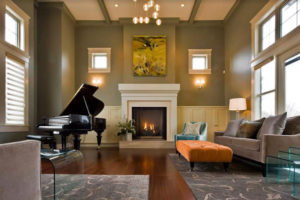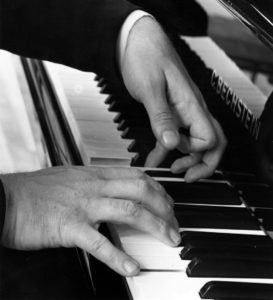J.S. Bach: Goldberg Variations (Glenn Gould)
Piano
a large keyboard musical instrument with a wooden case enclosing a soundboard and metal strings, which are struck by hammers when the keys are depressed
The pianist Ivo Pogorelich is right: the piano is “a piece of furniture”. Not simply a musical instrument, it’s fine furniture, often the most expensive piece in a home and the focal point of whatever room it’s in. Browse through glossy interiors magazines, Pinterest or sites like Houzz and you will find beautiful grand pianos in beautiful settings, the instrument not intended to be played, but to bring elegance, class and grandeur to a room. My 1913 Bechstein A, bought for a song (relatively-speaking), the most I could afford at the time, is a thing of beauty with a polished rosewood case, turned legs and a fretwork music desk. Visitors to the house gasp in admiration when I throw open the door to my office-cum-music room and there she crouches in burnished antique splendour.
Your wonderful Bechstein has afforded me great joy.
– Sviatoslav Richter

While upright pianos were two-a-penny in Victorian and Edwardian homes, as ubiquitous as the smart tv is today, the grand piano has always been a status symbol. A Picasso on the wall and a Steinway on the floor, the grand piano is an indicator of wealth and cultural cachet, for the grandest, most desirable pianos are as sleek, highly-engineered and as expensive as a Maserati, owned, but not necessarily played, by those who value image and exclusivity above ultimate usability.
The piano is also a machine, a miracle of invention, this contraption of metal, wood and wires capable of sustaining twenty-two tons of tension on its strings. Despite its industrial, apparently inanimate, construction, one is regularly reminded that this instrument is, like a violin or clarinet, created from materials which were once living: the slightest fluctuation in humidity will send my antique Bechstein into a stroppy fit of out-of-tune-ness as wood and ivory contract and expand.
You become elated, invigorated, and inspired….all through something built by a factory
– Menahem Pressler
The piano is a machine but it usually has soul, and a history too….. My Bechstein is Edwardian drawing rooms, overstuffed sofas, looking glasses, brocade and lace. It might have been sold out of the Bechstein piano showroom on Wigmore Street, next to Bechstein – now Wigmore – Hall, in that golden year when a carefree generation was teetering on the abyss of the First World War. A few years ago, I played a Steinway D with a special heritage. Formerly owned by the Hallé Orchestra in Manchester, it had been played by Sviatoslav Richter and Daniel Barenboim, amongst others – “and now you are playing it!” said its owner, for whose music society I was performing. I’ve also played a square piano owned and autographed by Edward Elgar, and a Pleyel said to have been played by Chopin, but one can invest too much in these associations, believing that the spirit of former owners and players haunts the keys and strings, and can influence the player. In fact, it is whoever is playing the piano now which sparks the soul of the instrument and brings it to life in sound.

Sviatoslav Richter’s hands, photographed in 1961
As a pianist, one has a special relationship with the instrument one plays most often (usually the piano one owns), but unlike other instrumentalists, the pianist cannot carry his/her own instrument to concerts (though in the old days concert artists might travel with their piano, taking it across the ocean to a concert at Carnegie Hall, New York). Thus, while it is true that most concert instruments are pretty much the same across the international venues and halls, one must also be adaptable or lower one’s expectations – not all pianos as are well looked after and cossetted as a concert Steinway…..In such situations, a true professional will accept the situation and work with the instrument they are given. The pianist Gary Graffman, in his book I Really Should be Practising, relates an occasion where he arrived at a concert to find that one of the notes on the piano when depressed sounded with all the subtlety of a gunshot: to remedy this, Graffman simply replaced the action of that note with one seldom-used from the top of the register.
The piano ceases to be a piece of furniture, or a machine, when it is played. The player brings it to life, and the great thing about the piano is that even the most novice player can get a pleasant sound out of it (unlike the violin for which students (and their long-suffering parents and teachers) must endure years of scraping and screeching before a beautiful sound is mastered).
The sound the pianist produces is determined by touch, by the finger’s contact with key. We call this “attack”, a curious descriptive word which suggests an aggressive connection with the instrument, when in fact the type of touch employed is often subtle, controlled, refined. Every pianist has a personal sound associated with their individual touch. Other instrumentalists, and physicists, may scoff at this, claiming that the only factor that determines the tone intensity and timbre is the speed of the hammer hitting the piano string, but studies have demonstrated that the subtleties of individual touch do influence timbre and quality of sound: pianists use a vast palette of timbral nuances to colour their performances and, importantly, to create a distinctly personal sound. Why else do we seek out the performances of certain pianists – Cortot, Lipatti, Gould, Lupu, Hough, Uchida – and can identify these pianists from a blind listening?
Franz Schubert: Piano Sonata No. 21 in B-Flat Major, D. 960 – I. Molto moderato (Mitsuko Uchida)
Arm weight, wrist flexibility and suppleness, lack of bodily tension – all these affect the sound, the mood and interpretation of every note and passage. A tense body creates a tense sound, for the music one produces inevitably imitates the state of the body. And the body responds to the mood of the music too: during passages of raging fury (Beethoven at his most declamatory), the heartbeat quickens and the body tenses.
A kind of synaesthesia comes into play (forgive the pun) in the most expressive and compelling performances. Timbre, an essential factor in the expressivity of performance, combined with touch and the pianist’s own temperament, their musicianship and intelligence – that is where the true magic occurs, a potent reminder that the production of sound is not simply mechanical nor technical. This is the great power of the pianist – to conjure sounds, and images, from that machine, that box of wood and wires, that piece of furniture.
And when the music is over, the lid is closed, and the piano returns to its somnolent position, silently crouching in a corner of the room, once again a piece of furniture.
Oh, but what a marvellous, magical piece of furniture!





Wonderful article, I am reminded that my newly-acquired Steinway B is only a piece of furniture—albeit a gorgeous one—until I sit down and play it, at which time it turns into a dream machine. The challenge for me always is to not get caught up on the technical aspects of playing but rather to focus on what I want to say with this exquisite instrument. The is something quite magical about a grand piano, and for me, especially a Steinway.
There was a piece written in the Nov., 1970 Piano Technicians GuildJournal with a quote from piano technician Don Galt, who provided an alternative view to the idea that without the pianist a piano is just furniture.
“There is little in appearance of a piano to reveal the massive forces that its members exert on one another, without respite, through many decades of time. It is only when the instrument absorbs the energy of the musician, translates it and throws it back as sound energy at small or great dynamic levels that the magnitude of these forces is hinted at. Even so, the dynamism of the pianist and the stolidity of the piano foster the illusion that the former, rather than the latter, is actually the source of the sound.”